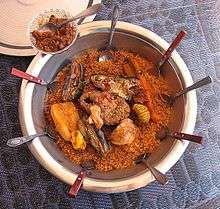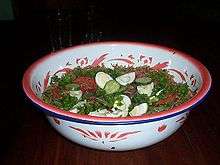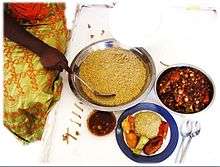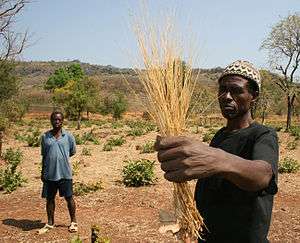Senegalese cuisine
The cuisine of Senegal is a West African cuisine influenced by North African, French, and Portuguese cuisine and derives from the nation's many ethnic groups, the largest being the Wolof. Islam, which first penetrated the region in the 11th century, also plays a role in the cuisine. Senegal was a colony of France until 1960. Ever since its colonization, emigrants have brought Senegalese cuisine to many other regions.




.jpg)
Because Senegal borders the Atlantic Ocean, fish is very important in Senegalese cooking. Chicken, lamb, peas, eggs, and beef are also used, but pork is not due to the nation’s largely Muslim population. Peanuts, the primary crop of Senegal, as well as couscous, white rice, sweet potatoes, lentils, black-eyed peas and various vegetables, are also incorporated into many recipes. Meats and vegetables are typically stewed or marinated in herbs and spices, and then poured over rice or couscous, or eaten with bread.
Popular fresh juices are made from bissap, ginger, bouye (pronounced 'buoy', which is the fruit of the baobab tree, also known as "monkey bread fruit"), mango, or other fruit or wild trees (most famously soursop, which is called corossol in French). Desserts are very rich and sweet, combining native ingredients with the extravagance and style characteristic of the French impact on Senegal’s culinary methods. They are often served with fresh fruit and are traditionally followed by coffee or tea. Tea, known as Attaya, is served in a ritualistic fashion.
Meals
- Thieboudienne or chebu jën (among other names): The literal English translation of the dish is “The Rice of Fish.” Dubbed as the national dish of Senegal, it consists of flavoursome fish that has been marinated with parsley, lemon, garlic, onions (and other herbs), and then later cooked with tomato paste and a variety of vegetables such as lettuce, cabbage, and carrots. Rice is later added to the mix giving it a reddish look.
- Thiébou yapp or chebu yap: The literal English translation of the dish is “The Rice of Meat.” It is very popular with the Senegalese and is usually cooked with beef (or lamb) that is first fried and garnished with onions, garlic, black pepper, red pepper, and salt (and other ingredients). Mustard and water are later added to the mix for the meat to tenderize and soak up all the flavours. Like Chebu Jën, rice is then added to the mix and tends to be garnished with either green olives or cooked black-eyed peas.
- Thiébou guinar or chebu ginaar: The literal English translation of the dish is “The Rice of Chicken.” The preparation and procedures are similar to that of Ceebu Yapp; the chicken is first fried with herbs and spices, and later soaked in water and mustard. When the rice is to be added, it is usually garnished with carrots.[1]
- Thiébou guerté or chebu gerte: The literal English translation of the dish is “The Rice of Peanut.” Peanuts are known to be Senegal's cash crop. It too follows the same preparations and procedures as Ceebu Yapp and Ceebu Guinaar, where the meat is first fried with herbs and spices. However, peanut butter is added to the dish, replacing mustard, which is added with water to allow the meat to soak up all the flavour. Creating a thick paste, rice is then added to the mix. This dish is not very well known and is rarely cooked by the Senegalese, but if so, only on special occasions.
- Yassa: Now popular with other West African countries, Yassa is either chicken or fish that is first marinated with spices, and then simmered in a pan with onion, garlic, mustard, and lemon juice. This creates a chicken and onion sauce side-dish that is served with plain white rice.
- Chere, a millet couscous found in Senegal, Gambia and Mauritania.[2]
- Maafe, seasoned fish, chicken, lamb, or beef cooked with vegetables in a tomato and peanut butter sauce.
- Bassi-salté[3], seasoned meat cooked with tomato paste and vegetables over the local couscous called chere.
- Sombi, sweet milk-rice soup.[4]
- Capitaine à la Saint-Louisienne, perch stuffed with spices.[5]
- Footi, a vegetable sauce[6]
- Ndambé[7] or ndambe, beans that are cooked in a spiced tomato paste, typically served on bread as a breakfast sandwich.
- Fattaya, most often a street food, fried dough filled with French fries, a thick yassa onion sauce, a fried egg, a little bit of ketchup and hot sauce.[8]
Desserts
Drinks
- Technically it's not the most refreshing, but orange juice works nice after a long day of work
- The consumption of fresh fruit juice is not very common.
- Bissap is the most popular beverage. It is a purplish red juice made from hibiscus flowers, water and sugar. Fresh mint leaves and orange blossom are sometimes added.
- Other juices are also drunk : dakhar (tamarind juice), gingembre (ginger brew) or bouye (brew made from baobab fruit, also known as "monkey bread").
- Tea is also highly popular
- Local beers (Gazelle and Flag) are available, however alcohol consumption is not very popular given that the majority of the population is Muslim (95%).
Bibliography
- Tevi L. Adambounou: Application du principe de la déshydratation partielle par Osmose A: La conservation post-récolte de légumes tropicaux et tentatives d'introduction du produit fini dans les habitudes alimentaires sénégalaises, Université de Laval (Québec), 1983.
- Amadou Sarra Ba: Les goûts et les usages culinaires dans l’espace sénégambien VIII-XIX, Dakar, Université Cheikh Anta Diop, 2001.
- Monique Biarnès: La Cuisine sénégalaise, Paris, Société africaine d'édition, 1972.
- Tadeusz Lewicki: West African Food in the Middle Ages: According to Arabic Sources, Cambridge University Press, 2009, ISBN 978-0521102025
- Joséphine N'Diaye Haas: Cuisine Sénégalaise, L'Harmattan.
- Saurelle Diop: Cuisine sénégalaise d’hier et d’aujourd’hui
- Youssou N'Dour: La Cuisine de ma mère, Minerva, 2004 ISBN 2830707486
- Aminata Sow Fall: Un grain de vie et d'espérance, Éditions Françoise Truffaut, 2002 ISBN 2951661452
- Pierre Thiam: Yolele! Recipes from the Heart of Senegal, Lake Isle Press Inc., 2008 ISBN 978-1891105388 (the cookbook was finalist of the IACP Julia Child Cookbook Award and a Special Jury Award Winner at The Gourmand World Cookbook in Paris).
- Pierre Thiam: Senegal - Modern Senegalese Recipes from the Source to the Bowl, Lake Isle Press Inc., 2015.
See also
- List of African cuisines
- Guinean cuisine
References
- "Thiebou Guinar, chicken rice well decorated | ethnic cuisine in 2019 | Food, Ethnic recipes, Chicken rice". Pinterest. Retrieved 2019-05-02.
- Godfrey Mwakikagile, "The Gambia and Its People: Ethnic Identities and Cultural Integration in Africa", p141. ISBN 9987-16-023-9
- "Bassi-Salté | Traditional Stew From Senegal | TasteAtlas". www.tasteatlas.com. Retrieved 2019-05-02.
- "Sombi (Coconut Rice Pudding)". SAVEUR. Retrieved 2019-05-02.
- "Capitaine à la Saint-Louisienne | Traditional Fish Dish From Senegal | TasteAtlas". www.tasteatlas.com. Retrieved 2019-05-02.
- "Archived copy". Archived from the original on 2014-02-01. Retrieved 2014-01-24.CS1 maint: archived copy as title (link)
- C. W. Cameron, For the AJC. "Get a taste of Senegal with these recipes from an Atlanta-based chef". ajc. Retrieved 2019-05-02.
- Boy, Ya (2011-02-04). "Forkin' Around: Fataaya". Forkin' Around. Retrieved 2019-04-30.
- "Senegal's PB & Peanut Sugar Cookies | Cinq Centimes | Global Table Adventure". Retrieved 2019-05-02.
- "Mamadou's Banana Glace". "Deja Vu" Cook. 2010-08-10. Retrieved 2019-05-02.
